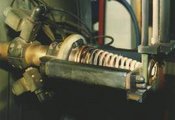Objective
About 30 years ago, a plasmadynamic accelerator has been installed at the Institute of Astronautics to simulate micrometeoroids. Since then, this specific accelerator principle has been developed furtheron and its performance was increased. The thus gained experience in design and operation of the plasma-dynamic accelerator lead to developments of other high performance accelerators. Those devices operate upon the principles of electro-thermal, electro-magnetic or electro-dynamic interactions and make usage of cpacitor stored energy.

Description
Plasma-dynamic Accelerator
The principle of the particle acceleration in the plasmadynamic accelerator is the generation of an ultrafast plasma jet by the surge current of an electrical energy source into an electrode assembly (plasm gun). A capacitor bank (352 µF; 16 kV) is discharged through ignitron switches into the plasma gun. With a few cm3 of Helium gas injected into the gun prior to the ignition, a Helium plasma is generated, which is accelerated along the coaxial electrodes by the interaction of electrical currents and magnetic fields. The plasma reaches a compressor coil with about 80 km/s. In the coil the plasma flow is compressed and the particles (typical size of several 10µm) that are exposed to the high-density plasma flow are drag accelerated.
The accelerator is installed in a vacuum tank (diameter: 85 cm; length: 220 cm). Via a connection tube, this tank is connected with the impact chamber (diameter: 90 cm; length 80 cm). The latter can be evacuuated up to 10-5 mbar. Typical areas of application are the simulation of micrometeoroids, the basic research on hypervelocity impact phenomena and the test and calibration of space experiments.
Electro-thermal Accelerator
The operating principle of the electro-thermal acceleration is the transfer of electrical energy into the thermal energy of a working gas. Heated and pressurized by an arc discharge, the working gas accelerates a projectile through a barrel to high velocities. The launcher system ccomprises an external energy source (capacitor bank) a high pressure discharge section and a launch tube with the projectile. To transfer the electrical energy into thermal energy, a conducting material is placed between the two electrodes of the discharge section. By discharging the capacitor bank, a high current starts flowing through the system and particularly through the conducting material in the chamber which is heated up, vaporized and ionized leading to a hot, high pressure plasma by Joule heating. From then on, the process of projectile acceleration is comparable to that of a common gas gun. The energy density per chamber volume, however, can be significantly higher than for one stage gas or powder guns. For projectile masses of about 25 mg, the maximum obtainable velocities in vacuum are up to 5,5 km/s. The launcher is small and fairly simple in operation. Therfore, it is also used in lab classes for students.
Electro-magnetic Accelerator
The electro-magnetic accelerator (also called "flat-coil" or "Eddy-current" accelerator) is a simlpy to operate launcher for dust particles. Final velocities are in the order of several 100 m/s. The high current from a capacitor bank discharge and its rapid change generates a rapidly changing magnetic field in a flat coil assembly. Hence, a strong Eddy-current is induced in a second conductor (simply a flat Aluminum disk with a diameter of 30 mm and a thickness of 0,5 mm). The induced current generates a magnetic field opposit to the primary field leading to a rapid acceleration of the disk (also called "sabot"). Particles, placed on the sabot will be accelerated, too. The sabot is decelerated at an annular stopper plate, whereas the particle moves towards the target. Design optimizations of the sabot lead to performance increases over the last years. Presently, steel balls with a diameter up to 2,5 mm can be accelerated up to 280 m/s. more light-weigth particles, however, can be accelerated in vacuum up to 400 m/s. Typical research fields are basic impact investigations at low velocities, the investigation of the sticking behavior of dust particles and the simulation of "domestic object damage" (DOD) in jet engines.